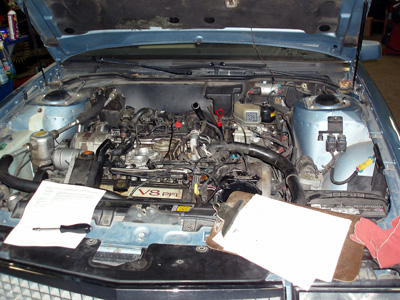 It’s a sign of the times that many people are bringing older vehicles into shops for repairs that they would not have considered several years ago. So it’s not unusual to see people spending more to repair a vehicle than its market value.
It’s a sign of the times that many people are bringing older vehicles into shops for repairs that they would not have considered several years ago. So it’s not unusual to see people spending more to repair a vehicle than its market value.
But, in some cases, the unemployed and under-employed of this Great Recession have sold their new cars and trucks and replaced them with older, “fixer-upper” vehicles. In other cases, the vehicle has sentimental or “collector” value to the owner and money is no object when it comes to keeping the family heirloom rolling.
This month’s Diagnostic Dilemma begins when a 1992 Cadillac Fleetwood (Photo 1) with a rough-running complaint was dropped off at a local under-car repair shop for a “tune up.”
Although this Cadillac is 20 years old, it has a body control computer and many other electronic features found on modern vehicles. Dated as the technology might be, this case study is particularly instructive of how multiple system failures coupled with gaps and misprints in technical information can drive a seemly simple diagnosis awry.
My client shop initially discovered that the distributor cap and coil had burned through due to excessively high firing voltages caused by worn spark plugs. 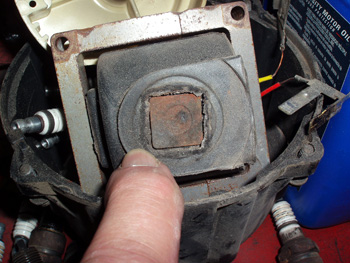
See Photo 2.
With the cap, rotor, coil, and spark plugs replaced, the engine stalled on the initial test drive and wouldn’t restart. Because my client retrieved a 023 DTC indicating a problem in the electronic spark timing (EST) system, he suspected that the stalling condition had been caused by the ignition system.
Early HEI Systems
In a long, around-about way, my client was entirely correct. When I attended one of the first General Motors High Energy
Ignition (HEI) system classes held at our area training school, we found that an HEI was entirely capable of producing a high-amperage spark of 50,000 or more volts.
The intensity of the spark would regularly perforate spark plug wires and distributor rotors at Colorado’s high altitudes. If a spark plug wire came loose or went open-circuit, the high primary voltage kick could also damage the ignition module. To prevent rotor and wire perforation at high altitudes, we reduced firing voltages by adjusting spark plugs from the original 0.060-0.080” gap to a 0.040” gap.
Do Your Homework First
With that said, it’s easy to see why we need to do our homework before going out on a mobile call. From previous experience, I knew that the early ’90s Cadillacs were notorious for fuel injector failures. With that in mind, I printed out the fuel injection wiring schematics and the diagnostics for Cadillac’s 023 DTC before I left my shop. Maybe the 023 EST code was real and maybe it wasn’t, but I had to be prepared.
To make the diagnosis even more difficult, these older vehicles were built when field information wasn’t as widely distributed or catalogued as it is in today’s Internet sources. In addition, lab scopes weren’t in common use back then, so the manufacturer’s diagnostic “trees” relied on the less reliable technique of measuring sensor signal strengths with a volt/ohm meter.
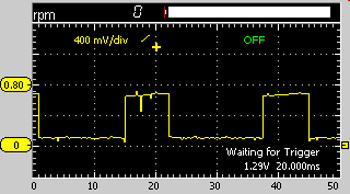 Last, I noticed that the ignition schematic before me indicated that the square-wave electronic spark timing signal originates from the ignition control module and is grounded in the ECM. In reality, the signal originates from the ECM and is grounded in the module.
Last, I noticed that the ignition schematic before me indicated that the square-wave electronic spark timing signal originates from the ignition control module and is grounded in the ECM. In reality, the signal originates from the ECM and is grounded in the module.
In addition, the text indicated that the ignition module “grounded” the EST signal from the ECM when, in fact, it simply pulled the voltage down from 5 volts to about 0.8 volts. The differences might seem insignificant, but can be very misleading for a technician with little knowledge of this system.
Spark or Fuel
The first step in diagnosing any cranking, no-start condition is to determine if the failure is spark or fuel related. The ignition system seemed to be eliminated as a primary failure after the engine cranked and sprang to life as I sprayed some aerosol throttle body cleaner into the throttle body.
With the fuel pressure to specification and a high cranking speed, I began to suspect that the Cadillac’s V8 engine was trying to start on four cylinders. A scope test confirmed that only half of the fuel injectors were firing. The wiring schematic indicated that the fuel injectors were powered by fuse numbers 21 and 22. Upon inspection, my client found that fuse 22 had blown.
Knowing of the Cadillac’s proclivity for shorted fuel injectors, I tested fuel injector resistance at each bank connector. Only two of the eight injectors tested to the OE specification of 16-17 ohms at room temperature with the remainder testing between 5 and 10 ohms. After replacing fuse 22 and starting the engine, a lab scope test confirmed that at least six injectors displayed waveforms indicating shorted windings.
So far, my diagnostic scenario indicated that the burned ignition parts made the Cadillac “run so terribly” that the shorted fuel injectors had gone unnoticed. Only when the tech took the Cadillac for a test drive would the injectors draw enough amperage to burn out a fuse.
Feeling that the problem was solved, I recommended replacing the injectors before I packed my clothes and camera gear to leave for the Automotive Service and Repair Week (ASRW) being held the following week in Las Vegas.
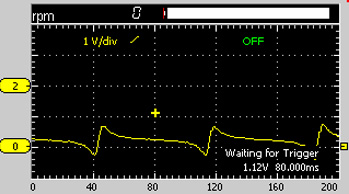 Electronic Spark Controls
Electronic Spark Controls
The new fuel injectors arrived shortly after my return. As specified by the supplier, I “buzzed” or pulsed each injector before installation. After installing the new injectors, the shop reported that the Cadillac would again crank, but not start.
Nothing is more disturbing than a failed diagnosis, especially if you’re operating as a mobile service. After arriving at the shop, I immediately noticed that the engine was misfiring through the intake manifold when cranked. Because it sounded like the fuel injectors or ignition timing was badly out of sequence, I suspected that the ignition control module (ICM) was defective.
In saying that, I should say that only twice in 30 years have I found an engine misfire caused by a bad ICM. One instance was an old “blue-grommet” Motorcraft ICM that would fire only alternate cylinders on a 360 cid Ford V8 engine. More recently, I had an ignition module on a ’90s Chevy S-10 Blazer that would misfire at low speed.
In the GM EST, the ignition module supplies switches the coil and maintains base timing as the engine is cranked. It also converts the analog signal from the distributor’s magnetic pickup to a digital distributor reference signal (DREF) that is sent to the ECM to time the fuel injectors. The ECM converts the fixed DREF signal (purple/white wire) to a variable EST signal that is returned to the ICM via a white EST wire.
During cranking, the ICM grounds the EST signal, lowering it from about 5 volts to about 0.8 volts in this application. See Photo 3. When the engine reaches a predetermined speed of 648 rpm, the ECM supplies a 5V signal to the ICM through a tan/black bypass wire. This bypass signal commands the ICM to advance spark timing from its base setting by accepting the signal from the white EST wire.
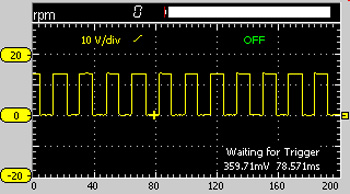 We often forget that there are still millions of vehicles on the road equipped with separate ICMs. Assuming that the distributor shaft turns and is timed correctly with the crankshaft, the simplest method for diagnosing a remotely located ICM is to test the B- ignition coil terminal for the presence of dwell angle or duty cycle.
We often forget that there are still millions of vehicles on the road equipped with separate ICMs. Assuming that the distributor shaft turns and is timed correctly with the crankshaft, the simplest method for diagnosing a remotely located ICM is to test the B- ignition coil terminal for the presence of dwell angle or duty cycle.
If the module isn’t switching the coil primary, the magnetic pickup coil must be tested for resistance and signal strength. If both values meet specifications, the module is defective.
See Photos 4 and Photo 5.
Because of the misfire during cranking, I thought the module was triggering the coil erratically. After verifying the magnetic pickup and the Hall effect camshaft position sensor operation with my lab scope, I speculated that the ICM might have been weakened by the high primary voltage kick induced by arcing in the distributor cap.
With that thought in mind, I recommended replacing the ignition control module. Needless to say, the shop replaced the ICM only to discover that the engine still had a cranking, no-start condition.
Alternative Fuel
Returning for a third time, I began to question my original diagnosis. In review, the Cadillac originally stored a 023 DTC, which indicated that this particular system had experienced a failure in its EST system, but would still start and run. After the defective fuel injectors were replaced, the engine failed to start and would misfire severely while cranking.
Although replacing the ICM eliminated the misfiring condition, the lack of fuel delivery through the fuel injectors prevented the engine from starting. Even with a normal fuel pressure of 40 psi at cranking, the engine would start and run with throttle body cleaner or propane being metered into the intake. A quick check with a lab scope indicated that the ECM was triggering the fuel injectors. Even with a “good” fuel injection waveform, we had no fuel delivery through the fuel injectors.
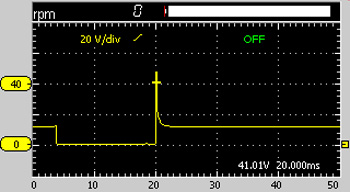 Fuel Quality Problems
Fuel Quality Problems
In years past, some of our local fuel outlets would receive gasoline contaminated with diesel fuel or gasoline that was so old it smelled like turpentine. But, during the past six years, I haven’t experienced fuel quality problems in our area.
Since our Cadillac did have a recently filled fuel tank, I decided to run known-good gasoline through the fuel rail.
To do this, I disable the fuel pump by removing the fuse or relay and use an old fuel injection flushing canister to pressurize the fuel rail. I usually increase the fuel pressure until the regulator begins bypassing the fuel to the tank. This process flushes the fuel rail. Then I slightly reduce the fuel pressure to start the engine. Unfortunately, the engine again failed to start.
ECM Failure Patterns
I knew that the old GM ECMs were notorious for cracked circuit boards. During my initial data scan, I noticed that my old scan tool wasn’t displaying battery voltage parameter identification (PID). In addition, at a normal throttle position sensor voltage of 0.93, the throttle opening PID indicated an 18% throttle opening. Using the client shop’s scan tool, the engine speed PID was missing and the throttle opening anomaly was duplicated. These anomalies could be a software issue with the scan tools or it could be real-time data.
The injector pulse width PID was indicating that the PCM was commanding a 16 millisecond (ms) injector pulse during cranking. Although the 16 ms command would disappear as it should in the WOT clear-flood mode while cranking, it did not change when I shorted the engine coolant temperature (ECT) sensor.
The scan tool’s ECT PID should have been drastically reduced at the indicated temperature of 320° F. At this point, I dismissed the 16 ms command as part of the cranking fuel strategy. But I kept these ECM-related anomalies in the back of my mind during the rest of the diagnostic process.
A Scope Solution
A scope waveform is sometimes worth a thousand words. At this point, I had stable ignition, correct fuel pressure, and known-good fuel injectors, but very little fuel being injected into the intake ports, despite the fuel rail being pressurized with fresh fuel from an outside source.
As I mentioned above, the lab scope waveform (Photo 6) verified the scan tool injector pulse width PID of 16 milliseconds. In the rush to diagnose other problems, hadn’t bothered to really examine the injector waveform in detail. But a re-examination of the waveform indicated that, at 42 volts, the voltage “kick” was low and the normally microscopic fuel injector pintle valve “bump” was completely absent. 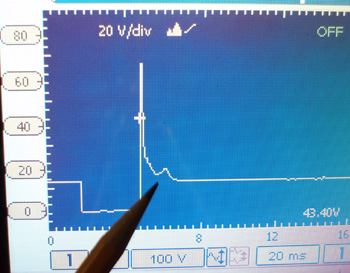
See Photo 7.
At this point, we had invested too many diagnostic hours in unraveling the Cadillac’s various system failures to spend even more time rehashing the diagnosis. So, at this point, I didn’t hesitate to replace the ECM. The low voltage kick and the missing pintle bump sealed the decision. My diagnostic scenario was that the ECM simply wasn’t supplying enough amperage to fully unseat the new fuel injectors.
After replacing the ECM, our hearts sank once again as I cranked the engine with no results. Thinking back, I recalled that we had previously disabled the fuel pump by removing the fuel pump fuse. After installing the fuse, the engine sprang to life and the injector pulse width came in at 9 ms at cold idle and dropped to 4 ms at hot idle. That’s as perfect as it could get in my book.
But for me, this wasn’t a big money-maker because of the PCM’s unexpected failure and the tortuous back-tracking I had to do on my testing procedures. If there’s a lesson to be learned from this month’s Diagnostic Dilemma, it’s that any diagnosis can and must become an open-ended process when you’re dealing with multiple component failures.












